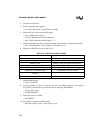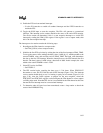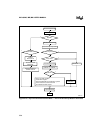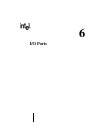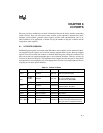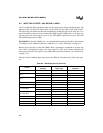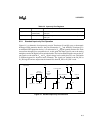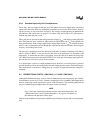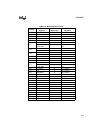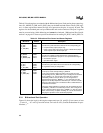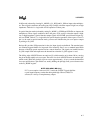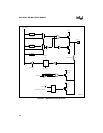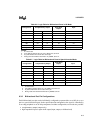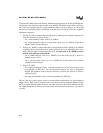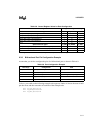
8XC196MC, MD, MH USER’S MANUAL
6-4
6.2.2 Standard Input-only Port Considerations
Port 0 and 1 pins are unique in that they may individually be used as digital inputs and analog
inputs at the same time. However, reading the port induces noise into the A/D converter, decreas-
ing the accuracy of any conversion in progress. We strongly recommend that you not read the
port while an A/D conversion is in progress. To reduce noise, the P0_PIN or P1_PIN register is
clocked only when the port is read.
These port pins are powered by the analog reference voltage (V
REF
) and analog ground (ANGND)
pins. If the port pins are to function as either analog or digital inputs, the V
REF
and ANGND pins
must provide power. If the voltage applied to the analog input exceeds V
REF
or ANGND by more
than 0.5 volts, current will be driven through Q1 or Q2 into the reference circuitry, decreasing the
accuracy of all analog conversions.
The port pin is sampled one state time before the read buffer is enabled. Sampling occurs during
phase 1 (while CLKOUT is low) and resolves the value of the pin before it is presented to the
internal bus. To ensure that the value is recognized, it must be valid 45 ns before the rising edge
of CLKOUT and must remain valid until CLKOUT falls. If the pin value changes during the sam-
ple time, the new value may or may not be recorded.
As a digital input, a pin acts as a high-impedance input. However, as an analog input, a pin must
provide current for a short time to charge the internal sample capacitor when a conversion begins.
This means that if a conversion is taking place on a port pin, its input characteristics change mo-
mentarily.
6.3 BIDIRECTIONAL PORTS 1 (MH ONLY), 2, 5, AND 7 (MD ONLY)
Although the bidirectional ports are very similar in both circuitry and configuration, port 5 differs
from the others in some ways. Port 5, a memory-mapped port, uses a standard CMOS input buffer
because of the high speeds required for system control functions. The remaining bidirectional
ports use Schmitt-triggered input buffers for improved noise immunity.
NOTE
Ports 3 and 4 are significantly different from the other bidirectional ports. See
“Bidirectional Ports 3 and 4 (Address/Data Bus)” on page 6-14 for details on
the structure and operation of these ports.
Table 6-4 lists the bidirectional port pins with their special-function signals and associated periph-
erals.



